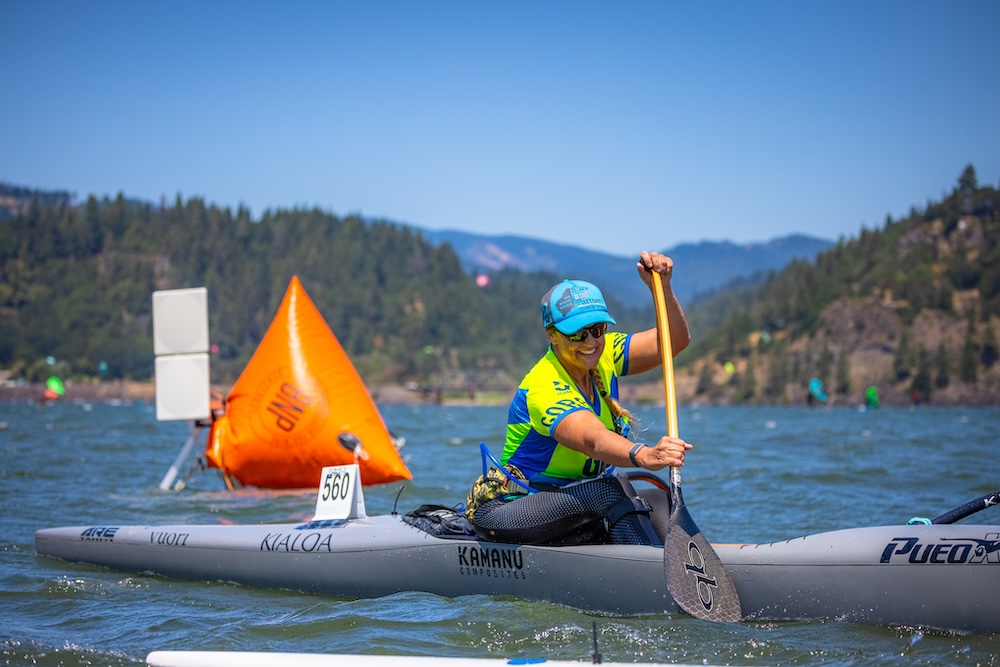There was a time when I was at my peak strength and fitness, but it didn’t translate to speed when I was paddling downwind. I would paddle as hard as I could, but my tempo was too slow and steady, and I was leaning heavily on my ama. Despite my efforts, I wasn’t getting faster in the surf, and I was frustrated by my lack of progress. It wasn’t until I realized that simply getting fitter wasn’t enough—I needed to develop specific surfing skills that set me up to surf, not just paddle, downwind.
My breakthrough came when I focused on improving my balance, increasing my stroke rate, and learning to adapt my tempo to the rhythm of the waves.
The Challenge of Downwind Practice
One of the challenges in learning downwind paddling is finding the right conditions to practice in. Many paddlers only have access to Gorge-like conditions a few times a year while other paddlers are not ready for big water yet. As a result, they struggle to make significant progress because they don’t get enough practice and focus mostly on fitness. However, downwind paddling requires more than just fitness; it requires honing specific surfing skills. Fortunately, these skills can be built by practicing on flat water.
The Solution: Practice Hard Moves in Easy Water
The key to improving your downwind paddling lies in practicing the right skills—even when you’re not in surf conditions. This approach, which I like to call “practicing hard moves in easy water,” involves breaking down essential surfing skills and perfecting them in flat water. By doing so, you’ll be more comfortable and capable when you finally get into challenging conditions.
Three Key Surf Skills to Practice
Here are three core skills you can develop in flat water to prepare for your next downwind session:
- Acceleration: Most paddlers don’t realize how fast they need to paddle to catch a wave. Work on developing fast-twitch muscle power in flat water by practicing short, intense bursts of very high tempo paddling. This will teach your body how to paddle at a very high cadence, which is essential for catching waves.
- Tempo Changes: A common mistake is not varying the tempo enough to stay on and link waves together. Many people are padding too slowly to catch waves and too hard or when they have caught a wave. Instead, focus on constantly varying your tempo, accelerating to catch and backing off to ride. Training this in flat water will condition you to repeat it over and over again, learning to smoothly transition your effort, which will make you more efficient and effective when you paddle downwind.
- Get Off the Ama: Leaning on your ama may feel stabilizing, but it actually slows you down and makes you less stable. In downwind conditions, the trim of your canoe is constantly changing, and you need to unweight the ama to maintain speed and stability. Practice this in flat water by learning to unweight the ama, which will reduce drag and improve your wave riding ability.
The Outcome: Improved Surfing Performance
By dedicating time to these skills in flat water, you’ll find yourself more prepared and more effective when the wind and waves are in your favor. When I began incorporating these skills into my training, I was able to catch more waves and link them together more smoothly, and my overall downwind performance finally caught up to my fitness.
The Core Skill: Mastering the Brace Stroke
No discussion of surfing skills would be complete without emphasizing the importance of the brace stroke. This crucial skill will prevent you from huling (capsizing) and help you feel confident enough to sit centered in your canoe, unweighted on your ama. Make the brace stroke a reflex—something you can rely on instinctively when conditions get tough.
Read Part 2 – Train OC1 Surf Skills on Flat Water

